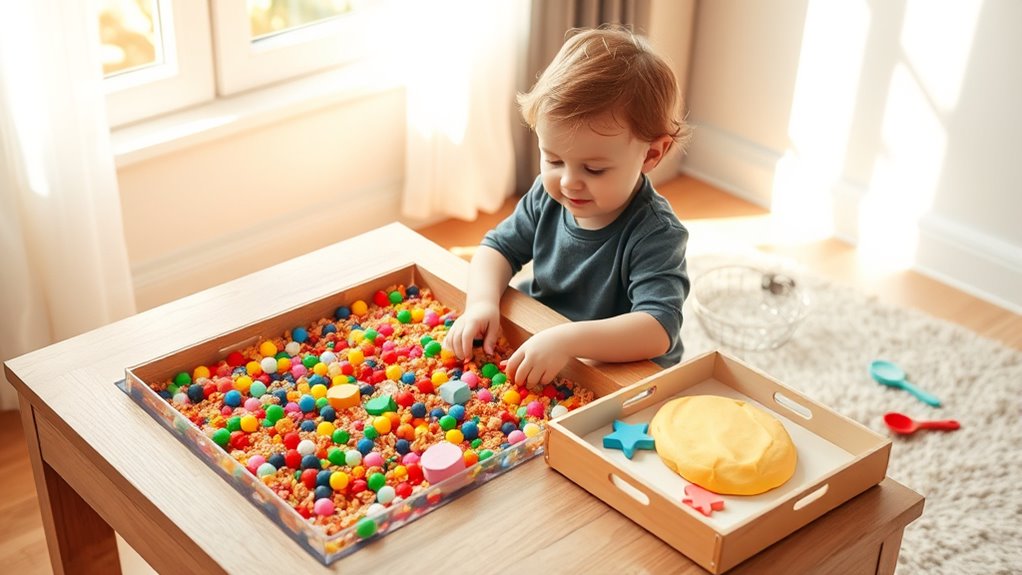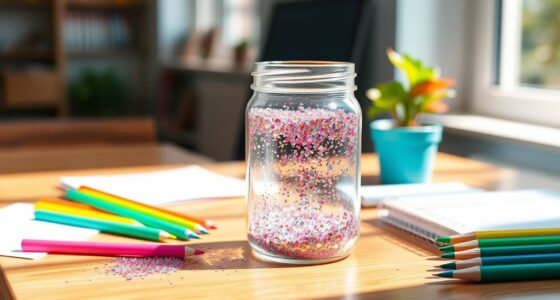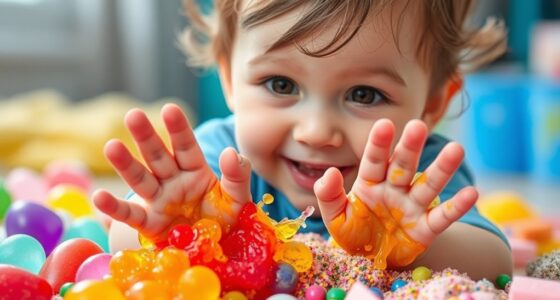To keep your toddler engaged and safe, try creating sensory play activities like exploring natural textures during outdoor walks, playing with simple musical instruments, or organizing treasure hunts with hidden objects. You can also have fun with finger paints, water sensory bins, or playing with soft fabrics. Incorporating movement and sound helps boost their development while keeping activities lively and secure. Keep exploring for more inventive ideas to make playtime both fun and educational.
Key Takeaways
- Use safe, age-appropriate sensory toys like shakers, textured balls, and rice-filled bottles for engaging exploration.
- Incorporate outdoor activities such as nature walks, collecting leaves, and sandbox play to stimulate multiple senses safely.
- Sing nursery rhymes and play musical games that encourage listening, movement, and emotional development.
- Organize simple sensory bins with safe materials like water, pasta, or beans for tactile exploration.
- Supervise all activities closely, ensuring a safe environment while fostering curiosity and sensory engagement.

Have you ever wondered how to keep your toddler engaged while supporting their development? One effective way is through sensory play, which stimulates their senses and encourages exploration. Incorporating music activities and outdoor adventures into your routine can make this both fun and educational. Music activities are fantastic because they help develop your child’s auditory senses, coordination, and rhythm. You can introduce simple instruments like drums, shakers, or even homemade ones such as rice-filled bottles. Singing nursery rhymes or playing musical games encourages your toddler to listen carefully and move to the beat, fostering their motor skills and language development. Dancing along to lively tunes not only entertains but also helps your little one improve balance and body awareness. These music activities create a multisensory experience that captures their attention and nurtures their creativity. Practicing gear shifting techniques during outdoor activities, like navigating uneven terrains, can also enhance their motor skills and spatial awareness. Outdoor adventures are equally essential for sensory development. Nature provides a rich, varied environment filled with sights, sounds, textures, and smells that stimulate your child’s senses naturally. Take your toddler on a walk through the park or backyard, encouraging them to explore different textures like grass, leaves, and rocks. You can enhance this experience by hiding small objects for a treasure hunt or collecting natural items like pinecones and flowers. These activities help refine their tactile and visual senses while promoting curiosity. Outdoor adventures also introduce your child to the natural world, fostering a sense of wonder and encouraging physical activity. Jumping over logs, climbing on low branches, or crawling through bushes offers great opportunities for gross motor development and sensory input. Combining both music activities and outdoor adventures in your child’s daily routine can provide a well-rounded sensory experience. For example, you might have a picnic outdoors where your toddler can listen to birdsong, feel the grass, and then play a musical game like marching or dancing to outdoor sounds. These activities support their cognitive and emotional growth while making learning enjoyable. Always remember to supervise closely during outdoor play and choose safe, age-appropriate instruments and materials. Keep activities short and varied to match your toddler’s attention span. The key is to create an environment that encourages exploration, stimulates the senses, and makes learning feel like an exciting adventure. With consistent, safe, and engaging sensory play, your toddler will develop essential skills while having loads of fun.
Frequently Asked Questions
How Do I Ensure Sensory Activities Are Safe for My Toddler?
To make certain sensory activities are safe for your toddler, always use safe materials that are non-toxic and age-appropriate. Supervision tips include staying nearby, watching for choking hazards, and guiding your child’s actions. Check toys and supplies regularly for damage or wear. Keep small objects out of reach, and teach your child to handle materials gently. These precautions help create a safe, enjoyable sensory experience for your little one.
What Are the Best Sensory Toys for Toddlers?
Thinking about terrific toy choices? You’ll want to explore sensory toy recommendations that promote playful learning and development. Look for the best sensory materials like soft fabrics, squishy silicone, and textured toys that captivate your toddler’s curiosity. These toys boost brain development and build fine motor skills. Prioritize safe, non-toxic options that are durable and easy to clean. With the right sensory toys, you create a stimulating, safe space for your little one to explore and enjoy.
How Can I Incorporate Sensory Play Into Daily Routines?
To incorporate sensory play into your daily routine, start by identifying opportunities for sensory integration throughout the day. You can adapt daily activities like snack time with textured foods or outdoor walks focusing on different sounds and sights. Simple routine adaptations, such as using varied fabrics during dressing or engaging in water play during bath time, help your toddler develop sensory skills naturally. This consistent approach makes sensory play a seamless part of everyday life.
Are There Any Sensory Activities to Avoid for Certain Children?
You should be cautious with sensory activities if your child has allergy concerns or choking hazards. Avoid items like small beads, nuts, or foods that could cause allergic reactions. Always supervise and choose age-appropriate materials. Steer clear of anything that poses a choking risk, such as hard or tiny objects. Focus on safe, non-toxic, allergy-friendly options to ensure your child enjoys sensory play without danger.
How Can Sensory Play Support My Toddler’S Development?
You might think sensory play is just messy fun, but it actually boosts your toddler’s development in surprising ways. By engaging their senses, you help improve sensory development, fine motor skills, and problem-solving abilities. Plus, it keeps your little one happily engaged, fostering curiosity and confidence. So, while it looks playful, sensory play is a powerful tool that supports your toddler’s growth and learning every step of the way.
Conclusion
With these sensory play ideas, you’ll turn everyday moments into magical adventures, much like Alice’s wonderland, where curiosity leads to discovery. Watch your toddler’s eyes light up as they explore textures, colors, and sounds, building confidence and joy along the way. Embrace these simple activities to nurture their imagination and growth, creating memories as vivid and enchanting as a fairytale. After all, every touch and taste opens a new door to wonder.










